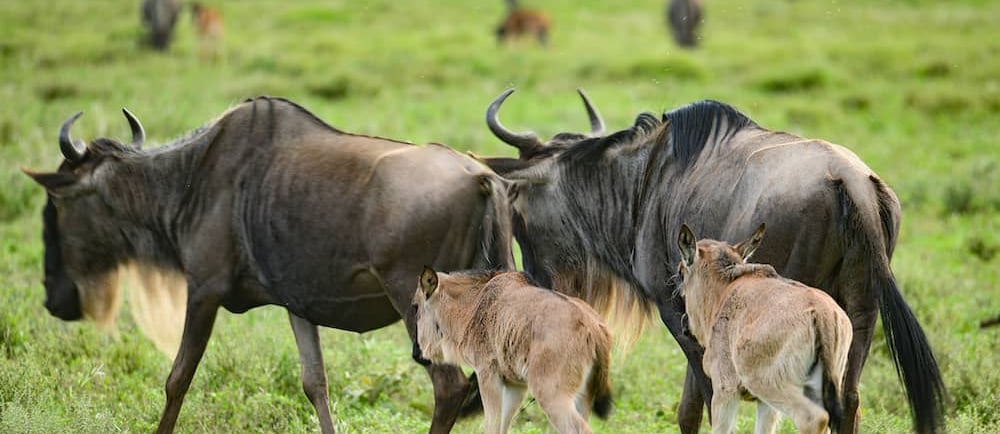Best Time to Visit Tanzania & Zanzibar (2025): Great Migration Safari + Beach Escape Guide
Explore Tanzania & Zanzibar in 2025: track wildebeest migration, enjoy safaris, and unwind on tropical beaches. The ultimate travel timing guide.


Introduction to Your Safari Adventure
Planning a trip to Tanzania? Knowing the best time to visit is key to having an unforgettable experience. Tanzania offers amazing wildlife, the spectacular Great Migration, and stunning beaches on Zanzibar. Each season brings unique opportunities. Read on to discover what to expect each month and choose the perfect time for your adventure.
December to March: Calving Season in Southern Serengeti and Ndutu Plains
From mid-December to March, the Southern Serengeti and Ndutu Plains come alive with the Calving Season, one of nature’s most extraordinary wildlife events.
What to expect:
Each month, approximately 50,000 to 60,000 wildebeest calves are born, attracting predators and creating intense wildlife drama.
Witness live births and see calves attempt to stand and walk just minutes after being born a truly remarkable sight.
Observe mother wildebeests, zebras, and other antelope species caring for and protecting their young from predators.
High chances of seeing predators such as lions, hyenas, and cheetahs hunting vulnerable newborn calves.
The Ndutu plains become a hotspot where large herds of wildebeests and predators concentrate, following the migration for food.
Enjoy spectacular wildlife scenes including hunting, predation, and survival.
The lush green plains provide beautiful scenery that enhances every game drive.
Nearby parks to explore:
Tarangire National Park: Famous for giant African elephants, you’ll see large herds roaming beneath majestic baobab trees, which the Maasai believe are the first trees created. Besides elephants, expect to see zebras, wildebeests, buffaloes, big cats, and a wide variety of bird species like ostriches and guinea fowls.
Ngorongoro Crater: This unique volcanic caldera offers perfect wildlife viewing year-round. It’s home to the Big Five, elephant, rhino, buffalo, lion, and leopard.
April to May: Green Season with Long Rains (Low Season)
April and May bring the long rainy season in Northern Tanzania, transforming the landscape into lush green beauty.
What to expect:
Frequent rain showers keep the scenery vibrant and perfect for photography.
The Great Migration herds move to Central Serengeti, especially around Naabi Hills.
Central Serengeti offers rolling plains and kopjes (rocky outcrops), great for spotting predators and plains game.
Few tourists visit during this time, making parks and lodges quiet and peaceful.
Safari prices are lower, offering great value.
Excellent birdwatching opportunities with many migratory and resident birds.
Roads may be muddy and some game drives could be affected by rain.
Ideal for: Travelers seeking solitude, lush scenery, and budget-friendly safari
June to Early July: Dry Season Great migration at Western Serengeti
As the dry season begins, the Great Migration moves from the Central Serengeti toward the Western Corridor, following fresh grazing paths along the way.
What to Expect:
The wildebeests and zebras gather in large numbers in the Western Serengeti, especially around the Grumeti River, an important stage in the migration route.
The grass is shorter, water sources become fewer, and wildlife becomes easier to spot.
The weather is dry and cool, making it ideal for game drives and photography.
Fewer tourists than in peak season (July–October), offering a more peaceful safari experience.
Grumeti River Crossing The First Major Obstacle:
This is where the herds face their first serious challenge: crossing the Grumeti River, which is home to some of Africa’s largest Nile crocodiles.
As thousands of wildebeests attempt to cross, many fall prey to the massive crocodiles lurking just beneath the surface.
The scene is both thrilling and brutal , a dramatic test of survival that provides an unforgettable wildlife moment.
This crossing is not as widely known as the Mara River event, but it is just as powerful and less crowded.
The Western Serengeti, with its mix of open plains, riverine forests, and valleys, is also rich in other wildlife including elephants, giraffes, hippos, and big cats like lions and leopards.
Mid July to October: Peak Dry Season and Mara River Crossing
This period is the peak dry season and the most famous time to witness the Great Migration’s dramatic river crossing.
What to expect:
Thousands of wildebeests and zebras cross the crocodile-infested Mara River in Northern Serengeti.
Over 1.5 million wildebeests migrate through the area.
Expect unforgettable wildlife action, but also more tourists and higher prices.
A perfect time for safari lovers wanting to witness one of Africa’s most iconic events.
November to Mid-December : Short Rains and Shoulder Season
The short rains start, bringing fresh greenery and continued great wildlife viewing.
What to expect:
The Great Migration herds begin moving back toward Central Serengeti and Naabi Hills.
Central Serengeti’s landscape is dotted with kopjes and wide-open plains, great for game viewing.
Wildlife is active and visible.
Moderate prices and fewer tourists than the peak season.
Good time for travelers looking to avoid crowds and enjoy green landscapes
Best Time for Beaches and Island Adventures
While Tanzania’s mainland is famous for safaris, Zanzibar offers beautiful white sand beaches, turquoise waters, and rich culture.
Best months: June to October and December to February.
Enjoy sunny weather perfect for swimming, snorkeling, diving, and exploring historic Stone Town.
Avoid: April and May when heavy rains are common
Zanzibar’s temperatures range from 25°C to 30°C (77°F to 86°F) year-round.
Final Tips
Plan according to your interests: Whether you want to witness dramatic wildlife events, enjoy quiet safaris, or relax on tropical beaches, Tanzania and Zanzibar have something for everyone.
Book early during peak seasons (July to October) to secure the best accommodations.
Prepare for varying weather: Bring appropriate clothing for rains or dry heat depending on the season.
We warmly invite you to experience the breathtaking beauty of Tanzania and Zanzibar any time of the year.
Start planning your adventure today and create an unforgettable safari and beach escape




